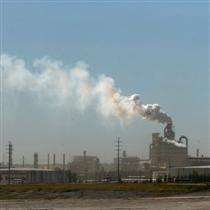

Partners to study nuclear role in oilsands
Alberta Research Council and U.S. energy department sign agreement
Gordon Jaremko
Edmonton Journal
Friday, March 28, 2008

CREDIT: Chris Schwarz/Edmonton Journal
The Alberta Research Council has signed an agreement
with the U.S. government to study the use of atomic
energy in the oilsands.
EDMONTON - Use of atomic power for oilsands development will be investigated by a research partnership, announced today, between the Alberta and United States governments.
The Alberta Research Council and the U.S. energy department's main nuclear laboratory in Idaho signed an agreement calling for work on potential bitumen belt applications of electricity, heat and chemical byproducts from reactors proposed north of Edmonton.
"This is a marriage made in heaven," said Idaho laboratory associate director Bill Rogers. Although no budget for the collaboration was announced, he said potentially all his operation's 3,800 scientists can be drafted into the Alberta project.
"The U.S. is dependent on Alberta for energy security," Rogers said, pointing to the province's "essential" role as the biggest source of increasing American oil and natural gas imports.
In the U.S. view, Alberta stands out for reliability and stability as a supplier, he emphasized. Elsewhere "we face nationalization of resources in countries that are hostile to the U.S.," Rogers said.
ARC vice-president Ian Potter said the partnership plans to work out a research agenda by late summer or early fall.
Potential topics range from making nuclear reactors provide heat for steam used in thermal oilsands production to production of hydrogen and oxygen used in high volumes by bitumen upgraders, Potter said.
"Meeting our province's electricity demands both now and in the future begins with reliable and clear information on all of the available energy options," said Mel Knight, Alberta's minister of energy.
"We welcome collaborations such as the one announced between the Alberta Research Council and Idaho National Laboratories to provide the solid analysis and research on the options available to address Alberta's unique needs."
gjaremko@thejournal.canwest.com
© Edmonton Journal 2008
Things like this don't come out of the blue, and just because BC has a no-nuclear energy policy, doesn't mean it isn't at the table. In fact, here it is at Idaho National Laboratories last fall. (www.inl.gov)
http://www.inl.gov/featurestories/2006-12-14.shtml
http://www.inl.gov/featurestories/2008-02-07.shtml
INL proudly describes its facilities thus:
"In operation since 1949, the Idaho National Laboratory is a government reservation located in the southeastern Idaho desert. At 890 square miles (569,135 acres), the INL Site is roughly 85 percent the size of Rhode Island. It was established in 1949 as the National Reactor Testing Station, and for many years was the site of the largest concentration of nuclear reactors in the world. Fifty-two nuclear reactors were built, including the U.S. Navy's first prototype nuclear propulsion plant. During the 1970s, the laboratory's mission broadened into other areas, such as biotechnology, energy and materials research, and conservation and renewable energy.
"INL consists of several primary facilities situated on an expanse of otherwise undeveloped terrain. Buildings and structures at INL are clustered within these facilities, which are typically less than a few square miles in size and separated from each other by miles of undeveloped land. In addition, DOE owns or leases laboratories and administrative offices in the city of Idaho Falls, some 25 miles east of the INL Site border. About 30 percent of INL's employees work in administrative, scientific support and non nuclear laboratory programs and have offices in Idaho Falls. These include engineers; scientists; and administrative, financial, technical and laboratory employees. "
http://www.inl.gov/visitorinformation/index.shtml
One of its largest projects is a $2.9 billion cleanup of earlier work:
"The Idaho Cleanup Project (ICP) involves the safe, environmental cleanup of the Idaho National Laboratory site, which has been contaminated with waste generated from World War II-era conventional weapons testing, government-owned research and defense reactors, laboratory research, and defense missions at other U.S. Department of Energy (DOE) sites. The 7-year, $2.9 billion cleanup project, funded through the DOE's Office of Environmental Management, focuses equally on reducing risks to workers, the public, and the environment and on protecting the Snake River Plain Aquifer, the sole drinking water source for more than 300,000 residents of eastern Idaho."
https://idahocleanupproject.com/